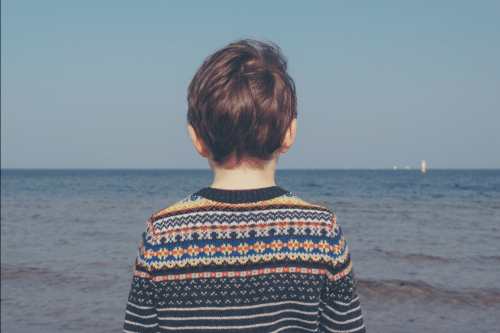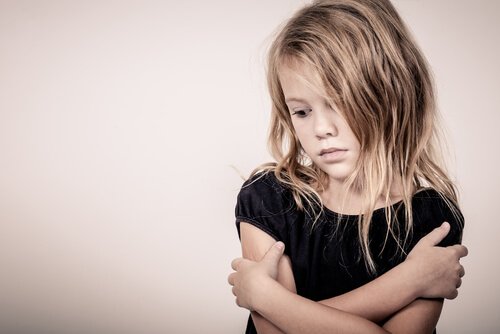Three Misconceptions about Children and Grief

Grief is a painful process that even children experience. However, we don’t always understand how they experience it. Actually, despite the fact that most children resolve their grief without major complications, it’s important to understand how they go through this process and debunk the misconceptions about children and grief.
This way, if our children have to face this painful situation, we’ll be able to help them in the best possible way. Now, in order to better understand these misconceptions, we first have to define exactly what grief is.
“I will not say do not weep; for not all tears are an evil.”
-J.R.R. Tolkien-

What exactly is grief?
Grief is a process with many stages that involves coping with a loss. Usually, it starts after the death of a loved one. However, it can also manifest after losing a job, a breakup, or the death of a pet, among other things.
According to psychologist Klüber-Ross, there are five stages of grief that a person must go through to overcome a loss. Each person will experience grief in their own way.
Here are the five stages of grief:
- Denial: During this stage, the person can’t believe what happened and uses denial to defend themselves from the pain. Their mind tries to find some way to stay sane despite the fact that the grieving person is extremely vulnerable.
- Anger: This stage begins when the person finally accepts the loss. During this stage, the person feels frustrated and impotent in the face of what has happened.
- Bargaining: The grieving person tries to find a way to reverse the situation. In the case of the death of a loved one, they may resort to religious or supernatural beliefs. Furthermore, the emotional pain will be stronger during this stage than any other.
- Depression: The person falls into deep desperation and sadness because they feel helpless.
- Acceptance: Finally, at this stage, the person accepts that what happened is irreversible. However, unlike in the previous stage, the person realizes that they can live with the loss. During this stage, they look back and learn from the situation.
On the other hand, it’s important to keep in mind that children experience this process differently, especially if they’re small. During the first years of their life, children are usually very physically and emotionally dependent. Therefore, they may not understand death and its consequences. However, what they do notice is the person’s absence. Consequently, they experience feelings of abandonment and lack of protection.
What are the most common misconceptions about children and grief?
Children don’t realize what’s happening
The most dangerous misconception about children and grief is that kids don’t know anything. It may be true that children don’t understand exactly what death is. However, they do notice the changes in their environment. Therefore, they’ll miss the person who has passed away. They’ll also notice that the adults around them are going through a difficult time.
The main problem with this misconception is that it leads people to not support children in the way they need. However, losing a loved one is also hard on them. Therefore, during this time, they need more love, attention, and understanding than ever before.

Their grief shouldn’t last long
This misconception has to do with the supposed adequate duration of grief. Some people wrongly believe that missing someone for a long time is a sign of weakness. Therefore, some parents believe that a child should overcome the death of a loved one as soon as possible.
However, this puts excessive pressure on the little ones. It will make them not only have to deal with their pain but also with the sensation of not meeting others’ expectations. In these situations, it’s necessary to understand that children need enough time to properly express their grieving.
Not all deaths lead to grieving
Lastly, some people believe that not all deaths should cause pain. However, emotions aren’t easy to control. Therefore, our children may have to mourn a loss that in theory shouldn’t be so hard on them. For example, this could be the case of the death of a pet or someone who wasn’t very close to them.
The key to this process is understanding. We must remember that children don’t choose to feel sad. Therefore, we have to be patient with them and help them to the best of our ability.
Grief is a painful process that even children experience. However, we don’t always understand how they experience it. Actually, despite the fact that most children resolve their grief without major complications, it’s important to understand how they go through this process and debunk the misconceptions about children and grief.
This way, if our children have to face this painful situation, we’ll be able to help them in the best possible way. Now, in order to better understand these misconceptions, we first have to define exactly what grief is.
“I will not say do not weep; for not all tears are an evil.”
-J.R.R. Tolkien-

What exactly is grief?
Grief is a process with many stages that involves coping with a loss. Usually, it starts after the death of a loved one. However, it can also manifest after losing a job, a breakup, or the death of a pet, among other things.
According to psychologist Klüber-Ross, there are five stages of grief that a person must go through to overcome a loss. Each person will experience grief in their own way.
Here are the five stages of grief:
- Denial: During this stage, the person can’t believe what happened and uses denial to defend themselves from the pain. Their mind tries to find some way to stay sane despite the fact that the grieving person is extremely vulnerable.
- Anger: This stage begins when the person finally accepts the loss. During this stage, the person feels frustrated and impotent in the face of what has happened.
- Bargaining: The grieving person tries to find a way to reverse the situation. In the case of the death of a loved one, they may resort to religious or supernatural beliefs. Furthermore, the emotional pain will be stronger during this stage than any other.
- Depression: The person falls into deep desperation and sadness because they feel helpless.
- Acceptance: Finally, at this stage, the person accepts that what happened is irreversible. However, unlike in the previous stage, the person realizes that they can live with the loss. During this stage, they look back and learn from the situation.
On the other hand, it’s important to keep in mind that children experience this process differently, especially if they’re small. During the first years of their life, children are usually very physically and emotionally dependent. Therefore, they may not understand death and its consequences. However, what they do notice is the person’s absence. Consequently, they experience feelings of abandonment and lack of protection.
What are the most common misconceptions about children and grief?
Children don’t realize what’s happening
The most dangerous misconception about children and grief is that kids don’t know anything. It may be true that children don’t understand exactly what death is. However, they do notice the changes in their environment. Therefore, they’ll miss the person who has passed away. They’ll also notice that the adults around them are going through a difficult time.
The main problem with this misconception is that it leads people to not support children in the way they need. However, losing a loved one is also hard on them. Therefore, during this time, they need more love, attention, and understanding than ever before.

Their grief shouldn’t last long
This misconception has to do with the supposed adequate duration of grief. Some people wrongly believe that missing someone for a long time is a sign of weakness. Therefore, some parents believe that a child should overcome the death of a loved one as soon as possible.
However, this puts excessive pressure on the little ones. It will make them not only have to deal with their pain but also with the sensation of not meeting others’ expectations. In these situations, it’s necessary to understand that children need enough time to properly express their grieving.
Not all deaths lead to grieving
Lastly, some people believe that not all deaths should cause pain. However, emotions aren’t easy to control. Therefore, our children may have to mourn a loss that in theory shouldn’t be so hard on them. For example, this could be the case of the death of a pet or someone who wasn’t very close to them.
The key to this process is understanding. We must remember that children don’t choose to feel sad. Therefore, we have to be patient with them and help them to the best of our ability.
This text is provided for informational purposes only and does not replace consultation with a professional. If in doubt, consult your specialist.







